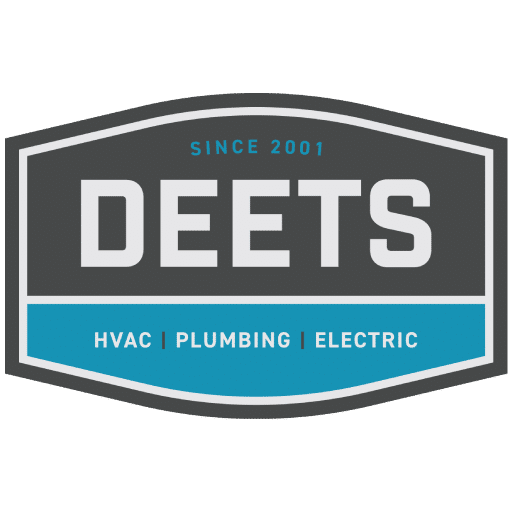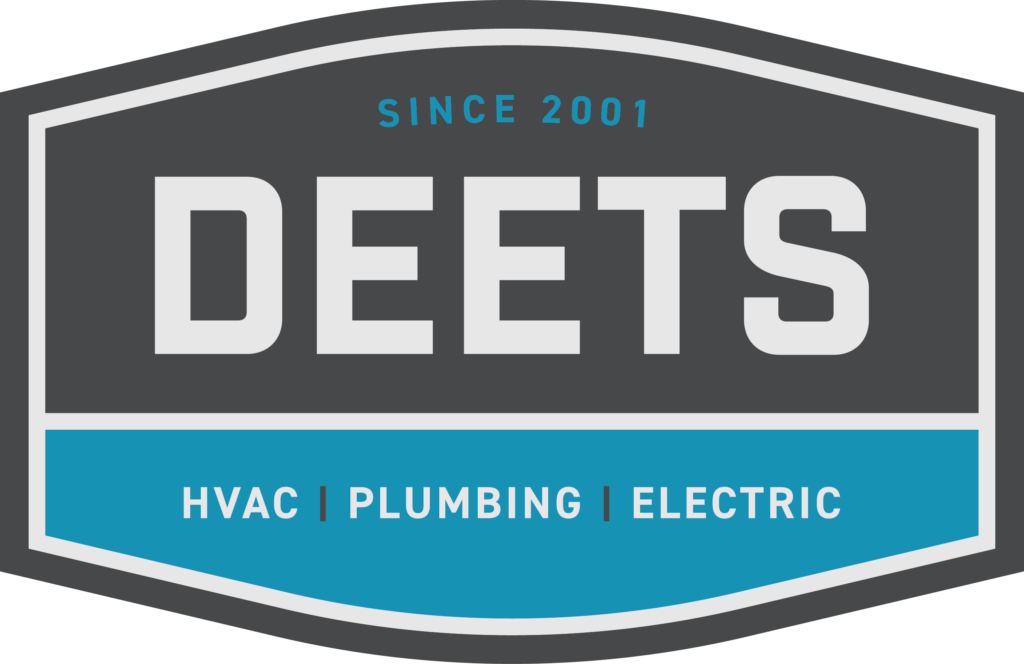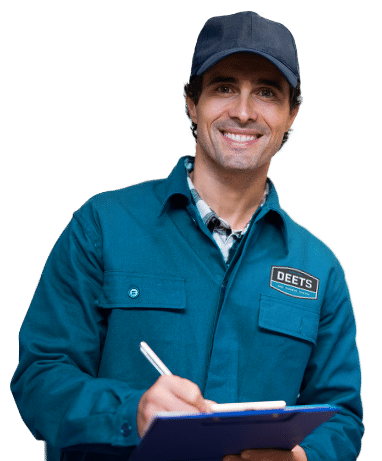In this article…
- De-Winterizing Your Seasonal or Vacation Home
- De-Winterizing Your Well Pump
- De-Winterizing Your Irrigation System
- De-Winterizing Your RV
- De-Winterizing Your Home Properly and Keeping Your Plumbing Running Smoothly
No matter how long you’ve lived up north, we all know winter takes a toll on our homes. That’s why you take extra precautions to protect your seasonal home and prevent any damage throughout the winter.
Now that Spring has arrived, it’s time to prepare your seasonal home, vacation home, or family camp. This includes de-winterizing your house and plumbing, which is a process that must be done properly and carefully to avoid damaging your home’s systems and ensure they are operating correctly.
Here at DEETS Mechanical, we’ve been helping homeowners protect their homes from harsh winter weather since 2001 and providing high-quality HVAC and plumbing services when you need them most.
Winterizing your home’s plumbing to prevent frozen pipes and damage is important. It’s also important to follow the correct steps to safely bring your system back to full operation, whether it’s in your seasonal home, vacation cabin, or RV.
This article will break down how to de-winterize your house correctly so you can ensure your home is ready for spring with no issues in sight.
De-Winterizing Your Seasonal or Vacation Home
Whether you’re a snowbird returning home for the summer or plan to use your family cabin all season long, properly de-winterizing your house is essential to ensure everything is working properly and avoid damage.
Having utilities in working order is the first crucial element for testing and restarting your plumbing and heating systems safely. It’s recommended for the ambient indoor temperature to be a minimum of 55 degrees to start.
This allows your HVAC system to start up slowly.
From there, you can start on the water supply by following these steps.
1. Reconnect Water Supply Tubes and Pipes
Slowly reconnect the water supply, starting with the main valve, and then gradually open valves on faucets, the hot water heater, and other appliances.
After doing so, check for leaks and ensure all air is purged from the lines.
Inspect and make sure all connections are secure and tight before turning on the water supply to avoid leaks.
2. Remove Aerators
Remove aerators from all faucets to allow any water buildup to drain out once your water supply is turned on. This will help prevent clogs and damage to your plumbing.
3. Check Supply Valves
Make sure all of your supply valves throughout the home are in the closed position..
This will allow you to charge up and inspect your plumbing section by section.
4. Gradually Turn On the Main Water Supply
Locate the main water supply valve, usually at the water meter.
Open the valve slowly, a quarter turn every 10-15 seconds, to avoid shocking the plumbing system with rushing water.
If you have a utility sink near the main shutoff valve, open the sink’s shutoff valve and the faucet as you gradually turn on the main water supply to help alleviate pressure.
5. Check for Leaks and Air
Continuously check for leaks throughout the house as water returns throughout the plumbing, especially at connections and pipes.
Ensure all air escapes from the water lines by opening faucets and letting them run until water flows steadily.
If you have a well, ensure the well pump is functioning correctly and the pressure switch is adjusted properly.
6. Turn On Appliances
Once the main water supply is on and you’ve checked for leaks, turn on the water heater, water softener, and any other water-supplied appliances.
Follow the manufacturer’s instructions for each appliance.
7. Final Checks On Plumbing
Check all plumbing fixtures are functioning properly and there are no leaks around sinks, water heaters, or water softeners.
8. Address Low Water Pressure
If you notice low water pressure, check for clogged faucets and fixtures, adjust the pressure switch, clear clogged water lines, install a water softener, or install a water pressure regulator.
If any of your plumbing doesn’t seem to be running properly or there is a problem you’re unsure of, it’s always best to call a professional.
De-Winterizing Your Well Pump
For homes that rely on a private well system, additional steps are required to safely restore water supply. A well system requires careful reactivation to avoid pump damage and contamination.
Step 1: Turn Off the Water Shutoff Valve at the Tank
Close the main shutoff valve at the pressure tank to control the flow of water before starting the de-winterization process. This ensures that any leaks or pressure issues can be addressed before allowing water to circulate.
Step 2: Ensure the Valve Between the Water Pump and Pressure Tank is Open
Opening this valve allows for proper pressure regulation and prevents damage. If left closed, it can cause pressure surges that may damage the system.
Step 3: Prime the Pump (For Above-Ground Pumps Only)
Submersible well pumps do not require priming, but above-ground pumps need clean water added through the priming port. This ensures the pump is properly lubricated and prevents dry operation, which can damage internal components
Do not operate the pump without water, as this could cause severe damage to the impeller and other internal components. Dry operation can result in expensive repairs.
Step 4: Turn on the Water Pump
The pump should pressurize the water tank and turn off once it reaches normal pressure levels. If it does not, there may be an issue with the pump or pressure switch.
Monitor the system for short cycling (turning on and off rapidly), which could indicate an issue with the pressure switch or air chamber
Step 5: Check for Leaks
Inspect the main valve, pump, tank, and supply pipes for leaks. Leaks in well systems can cause contamination and pressure loss.
If any leaks are found, shut off the system and repair or replace damaged components before continuing.
Step 6: Open Water Shut-Off Valves Throughout the Home
Open each shut-off valve one by one, checking for leaks before moving on to the next area. This prevents flooding in case of undetected damage.
Look out for changes in water pressure and listen for unusual noises, such as air escaping or gurgling sounds, which may indicate trapped air in the pipes.
Be sure to check for leaks around each fixture and appliance, especially under sinks and around toilets.
Step 7: Run Water and Inspect Fixtures
Turn on each fixture briefly, using only a small amount of water at first. This allows pressure to build evenly and prevents sudden surges.
Flush toilets and let water run in sinks and showers to clear out any remaining air pockets and remove any antifreeze that was added during winterization.
Step 8: Final System Check
Once all valves and fixtures have been checked, allow the system to run for about 30 minutes. This helps confirm that there are no lingering issues before resuming normal use.
Recheck all fittings, joints, and valves for leaks after normal water usage begins. Small leaks may take time to become noticeable.
If any irregularities arise, like inconsistent pressure, pump failure, or leaks, contact a professional well contractor.
De-Winterizing Your Irrigation System
If your home has an irrigation system, additional steps will need to be taken to de-winterize the system. If you must de-winterize on your own, here are some important things you need to know.
Note: This section is for de-winterizing irrigation systems such as sprinkler systems or greenhouse systems, not agricultural or commercial irrigation systems.
Step 1: Turn On the Main Valve
Turn on the water to the irrigation system at the main valve.
It’s important to note that sometimes the valves may leak a little when first turned on. However, it should only leak for a short time. Keep an eye on it and make sure it is not continually running.
Step 2: Sprinklers
For the next step, it is a good idea to remove the sprinkler head at the end of each line before turning on the sprinkler valves to flush out the line of any debris and to protect against the water hammer in case you turn on the valve too quickly.
Turn on the sprinkler valves one by one to check for any leaks. If the line is broken underground, it may take some time to bubble up.
Step 3: Repair Any Damage
Dig up and repair any leaks and replace sprinkler heads that are broken or contact a local landscaping or irrigation company for professional help.
Step 4: Set A Timer
Set watering times for a time when you can keep an eye on them to make sure everything is working properly. ‘
If you suspect damage to your irrigation system or something doesn’t seem quite right, remember it’s always best to contact a professional.
De-Winterizing Your RV
If you winterized your RV before storing it away for the colder months, you’ll need to carefully de-winterize it before hitting the road again. This process involves flushing out antifreeze, checking for leaks, and ensuring all systems are functioning properly.
Here are some important steps to follow to de-winterize your RV or camper.
Step 1: Inspect the Exterior
Check for cracks, leaks, or damage to the roof, windows, and seals. Winter weather can cause wear and tear, leading to potential leaks when exposed to rain.
Inspect the tires for cracks, deflation, or dry rot. Cold temperatures can cause tires to lose pressure, and sitting for long periods can weaken the rubber.
Step 2: Recharge or Replace Batteries
Check all batteries, including the house and engine batteries. Batteries lose charge over time, and extreme cold can reduce their lifespan.
Clean any corrosion from battery terminals to ensure a good connection and proper function.
Remember to charge or replace batteries as needed before attempting to start the RV.
Step 3: Flush and Sanitize the Water System
If antifreeze was used, drain it completely from the freshwater tank, lines, and hot water heater. RV antifreeze is non-toxic but should not be consumed.
Then, flush the system with fresh water by opening all faucets and letting the water run until it runs clear.
Sanitize the water system by adding a diluted bleach solution to the freshwater tank (typically ¼ cup of bleach per 15 gallons of water), running it through the lines, and letting it sit for a few hours before flushing again.
Step 4: Check for Plumbing Leaks
Inspect pipes, fittings, and connections for any signs of leaks caused by freezing temperatures.
Turn on the water pump and let the pressure build. If the pump continuously runs, there may be a leak that needs to be addressed.
Check under sinks, around toilets, and near the water heater for any visible drips or moisture.
Step 5: Test Safety Devices and Appliances
Check smoke detectors, carbon monoxide detectors, and fire extinguishers to ensure they are functional.
Inspect propane lines and test for leaks using a soapy water solution at connection points. If bubbles form, this indicates a leak.
Turn on appliances such as the stove, refrigerator, and water heater to ensure all is working properly.
Step 6: Inspect the Engine and Generator
Check all fluid levels, including oil, coolant, and brake fluid. Fluids can degrade over time and should be topped off or replaced as necessary.
Start the generator and let it run for a while to ensure it is operating properly before a long trip.
Inspect belts and hoses for cracks or wear that may have worsened over winter storage.
Step 7: Clean the Interior and Exterior
Vacuum and wipe down surfaces inside the RV to remove dust, mold, or mildew buildup. Check for any rodent or insect infestations that may have developed during storage.
It’s also a good idea to give your RV a good wash to inspect the seams for potential leaks before heading out on the road.
De-Winterizing Your Home Properly and Keeping Your Plumbing Running Smoothly
Now that you have a full guide to de-winterizing your home appliances, well pumps, irrigation systems, and RVs, you can properly prepare to de-winterize your home and avoid potential damage moving into spring.
De-winterizing your home’s plumbing and related systems is a crucial step in transitioning from winter to warmer months, whether it’s your main home, vacation or rental property, or home on wheels.
Each step serves a purpose in preventing damage, ensuring efficiency, and providing peace of mind, which is why it is essential to follow a step-by-step guide.
If you’re ever unsure about any part of the process, consulting a professional plumbing or HVAC company can save you time, money, and hassle. The last thing you want is to accidentally damage your home, right?
By taking these precautions, you can ensure your home remains safe, functional, and comfortable throughout the year.
DEETS Mechanical is here for all your HVAC, plumbing, and electrical needs, especially after the winter. Although we don’t service RVs and campers, we’re here to educate you on all you need to know for properly de-winterizing your homes.
Our team of expert technicians and licensed plumbers are here to carefully assess your home, provide you with the right diagnosis, and guide you to the best solution for you.
Are you worried your plumbing may have sprung a leak or interested in upgrading your HVAC system before summer? We’re here to help.




